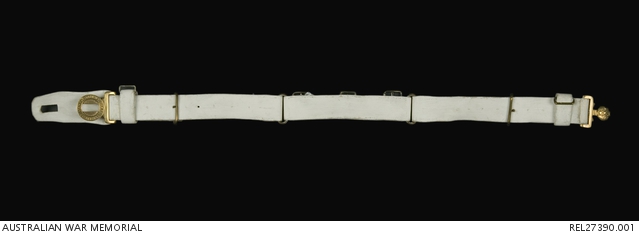| Place | Oceania: Australia, New South Wales |
|---|---|
| Accession Number | REL27390.001 |
| Collection type | Heraldry |
| Object type | Uniform |
| Physical description | Brass, Buff leather |
| Maker |
Unknown |
| Date made | c 1891 |
| Conflict |
Australian Colonial Forces, 1854-1900 |
Other Ranks 1888 Pattern (Mark II) Valise Equipment waist belt : New South Wales Military Forces

Buff leather waist belt, 1888 Pattern (Mark II) Valise Equipment (described in List of Changes 6504 March and April 1891) with NSW Other Ranks cast brass union locket buckle. The belt is made in three sections (measuring 1 3/4 inches in width) joined with sewn-in brass loops. An adjustable billet and brass buckle lie at each end so that the length can be adjusted while keeping the loops in their proper positions for braces when worn. Three brass buckles are secured between two layers of stitched leather in the centre back section of the belt. The two outer buckles attach to braces when worn; the centre one attaches to a mess tin strap. A running loop with a brass D loop is provided at each end of the belt for the front of the brace to pass through. The belt has a shaped and tapered safe (tongue) behind the buckle which is secured by passing the belt through a slit cut in the safe. The tongue of the buckle depicts the cross of St George with a lion in the centre and four eight-pointed stars at each corner representing the Southern Cross. The circular surround has the words ‘NEW SOUTH WALES MILITARY FORCES’. The belt is stamped in ink with a number of markings which are illegible except for 'GA20'.
The 1888 Pattern Valise Equipment was also known as the Slade-Wallace equipment, after its two designers, Colonel Slade and Major (later Lieutenant-Colonel) Wallace. The complete equipment consisted of a waist belt, two ammunition pouches, a pair of braces with movable buckles and a keeper, two greatcoat straps, a mess-tin strap, and a valise to carry clothing, cutlery and other personal equipment. This pattern was issued to British and colonial forces but was replaced with 1903 Bandolier equipment after its performance was criticised in the Boer War. The 1888 Pattern equipment was in service at most for 15 years though some parts such as waist belts, were retained for ceremonial purposes. The Mk II pattern waist belt varies from the Mark I in that the belt is made of three sections of leather joined by brass rings and not one piece as in the original pattern. The three buckles of the back section are secured within a double-thickness of leather instead of individual pockets as in the original pattern. NSW infantry and artillery are shown wearing this pattern of belt and locket buckle in the 1890s.
- 1888 Pattern Valise Equipment braces and straps : British and colonial forces
- 1888 Pattern (Mark III) Valise Equipment ammunition pouch : British and colonial forces
- 1888 Pattern (Mark III) Valise Equipment ammunition pouch : British and colonial forces
- 1888 Pattern Valise Equipment strap : British and colonial forces
- General Service (Mark II) bayonet frog : British and colonial forces